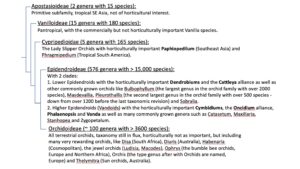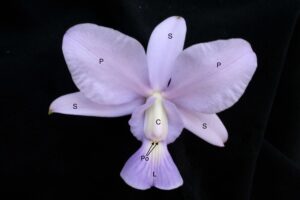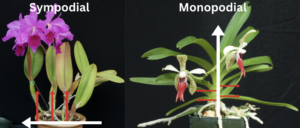Orchids, scientifically known as Orchidaceae, are an enchanting and incredibly diverse family of flowering plants. With over 28,000 recognized species, organized into 5 subfamilies and about 800 genera, and an array of hybrids, they rank as the second-largest plant family, behind only the Asteraceae. Orchids are celebrated for their intricate and diverse flowers, which come in an astounding range of sizes, shapes, colors, and scents.
Orchids got their name from the genus Orchis (the type genus), coming from the Ancient Greek word ὄρχις (órkhis), literally meaning “testicle”, because of the shape of the twin tubers in some species of Orchis. The term “orchid” was introduced in 1845 by John Lindley as a shortened form of Orchidaceae.
Orchids can be found worldwide, except in Antarctica, and thrive in diverse ecosystems, from tropical rainforests to arctic tundras. Their highest diversity is found in tropical regions, with Ecuador boasting the highest number of recorded species, nearly 3500 in total. The majority of tropical orchid species grow as epiphytes on trees, while a few inhabit rocks (lithophytes) or the ground (terrestrials). Orchids from temperate regions typically grow as terrestrial plants. The majority of cultivated orchids are epiphytes, necessitating specific culture for them to flourish (refer to General Orchid Culture for more details).
Orchids: Evolution and Classification
Orchid classification has been revised frequently over time, due the vastness and diversity of the family encouraging both lumping and splitting attempts. Recently, genomic data has been used to supplement morphological traits in classification, providing a molecular clock that estimates the evolutionary splitpoints of the subfamilies and family’s age.
Contrary to previous beliefs, orchids are much older than previously thought, now estimated to be ~100 million years old, meaning they likely coexisted with and survived the dinosaurs.
The latest taxonomic revision for the entire family in 2015 produced a new phylogenetic tree, using information from plastid and nuclear DNA in addition to morphological traits.
The image shows a simplified phylogenetic tree for hobbyists, emphasizing the horticulturally relevant genera (bold in the picture) and mentioning a few others for advanced orchid enthusiasts.
In summary, the Epidendroideae subfamily provides nearly all the genera relevant to the hobbyist, with the small Cypripedioideae subfamily providing the rest. The Orchidoideae subfamily has a handful of species with captivating flowers, but is not a horticultural staple.
Flower Morphology:
Their remarkable flower diversity reflects their ability to adapt to various environments and attract specific pollinators effectively. Orchid flowers have modified the typical 3 sepal (S) – 3 petal (P) arrangement to form a unique flower structure (see image) using a modified petal, called the lip or labellum (L), to create bilateral symmetry and serve as a landing platform for pollinators. The lip’s design, along with a specialized reproductive organ, the column (C), and pollen fused into packets called pollinia (Po), ensure efficient and specific pollination.
Growth:
Orchids show two distinct growth patterns (Monopodial and Sympodial) that impact how orchids should be cared for, so it’s important to recognize which type your orchid displays. The picture on the left shows typical examples, the white arrows indicate the direction of overall plant growth while the red arrows illustrate the successive new growth.
Sympodial Growth:
Orchids with sympodial growth grow horizontally along a “rhizome” from which the new main growth emerges vertically often producing a water storage organ called “pseudobulb” with one to a cluster of leaves and often terminating in a flower spike. The next growth emerges from the bottom of the old growth once it ceased growth, matured and flowered. The vast majority of orchids show this growth pattern, well known examples are Cattleyas, Oncidiums, and Dendrobiums.
Monopodial Growth:
Orchids with monopodial growth have a single, upright stem that continuously grows upwards. New leaves (produced along this stem in an alternating pattern) and flowers emerge horizontally from the tip of the main stem. Well known examples are Phalaenopsis and Vandas.
Roots:
Epiphytic orchids have evolved a unique adaptation to their environment, characterized by frequent but sporadic rainfall, leading to brief periods of water availability. Due to this limited duration of water supply, orchids must efficiently absorb water and nutrients. To accomplish this, orchid roots feature a thick, spongy outer layer known as the velamen (or Velamen radicum), which encases the slender central root responsible for water transport to the leaves. The velamen enables the quick up-take of the early rainwater that is rich in dissolved nutrients. When dry, the velamen appears white to silvery-white, due to air pockets in the velamen reflecting light and hiding the chlorophyll-containing root cells (hence the name velamen = veil). Conversely, when saturated with water, it takes on a green hue, now revealing the underlying chlorophyll content of the root. Monitoring the velamen’s color provides a reliable indicator for optimal watering timing. The image on the left shows the same plants (Barkeria spectabilis having a thick velamen) before and after a brief misting – the color change from white to green is clearly visible.
Cultural Information (General Culture Guide TBD) is in progress; Outdoor Growing in San Diego (Recommended Species List for Outdoors), Monthly Calendars are TBD.
Members are welcome to contribute – please email the webmaster.




